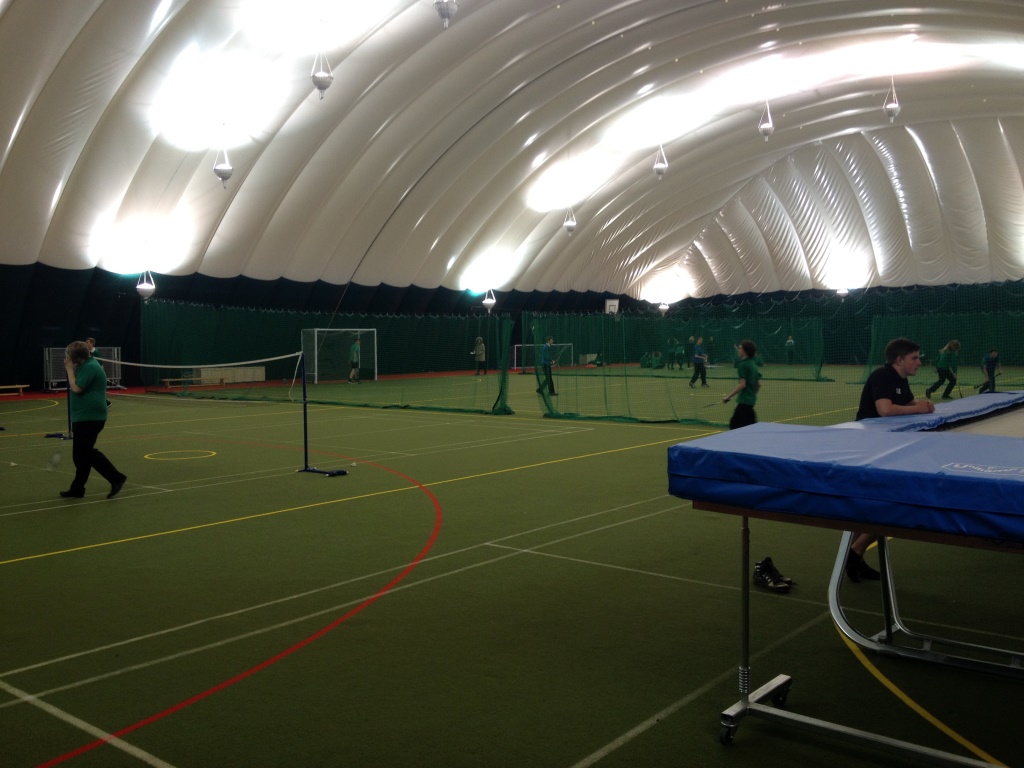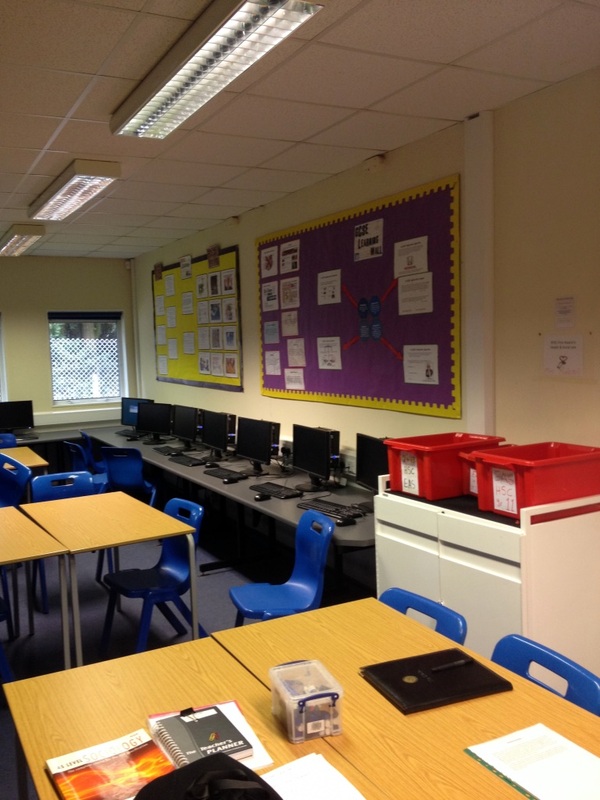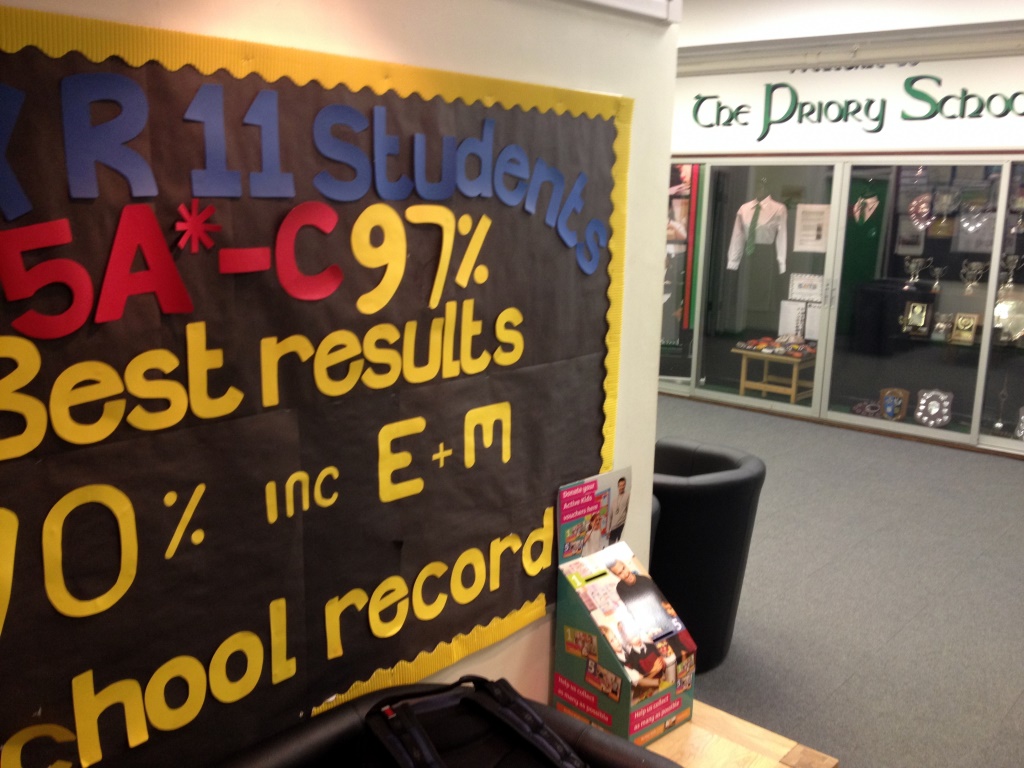| I was visiting my cousins this week in Dorking and was looking to visit some schools. Luckily they have a friend, Stuart, a local youth worker and former(-ish) teacher. He’s a great guy who does chaplaincy activities and functions as a guidance counselor for The Priory School, a Church of England (CofE) school with Years 7 to 13 (US Grades 6 to 12, ages 11 to 17). He was kind enough to get me into the school and observing lessons across several years. I got my visitor’s badge and met Stewart in the office, moving to the staff room for the morning briefing. Stewart introduced me to the gathered teachers and after the meeting I met a fellow “colonial”: a music teacher from Kansas! I then got to see a Year 7-8 (G6-7) assembly in the multi-purpose room, which began with the whole room singing a pop song, used to convey a message. Most assemblies have a religious theme, due to the school’s association with the Church of England, and focus on some moral message they want to impart on the kids. | [As a side note, I’ll refer to the UK’s “Years” as Y#, then put the US’s “Grade” in parentheses as G#. To determine the age of the students: add 4 to the year number or 5 to the grade number.] Next was a Y7 (G6) PE lesson on rugby, the first Physical Education lesson I’d seen in a UK school. There were two teachers, one male and one female, and after the children changed into their gym uniforms (polo shirts, shorts, and cleats), the genders split up. I went with Coach Mark and the boys to do some rugby, and I got to lead the warm-up exercises while he set up the pitches. I cannot stress this enough: kids in the US and the UK ARE NO DIFFERENT. The boys behaved just as their counterparts across the ocean do at this age. After this lesson I saw a Y11 PE lesson where, similar to my high school gym classes, the students (again split by gender) got to pick from several activities (field hockey, badminton, and trampolining). |
After the 15 minute break time, I went to go see a Y12 (G11) AS-level sociology class, held in a classroom with computers around the back of the roo. Just after I had gotten the hang of the whole “everyone wears a uniform” thing, this class was wearing “street” clothes. Upon further inquiry, the teacher (Mr. Harrison) explained that most 6th-formers across the country don’t actually wear uniforms. The lesson, on China’s one-child policy, had an introduction, small-group work, then a whole-class recap and the assigning of homework.
| As the students broke into their groups, I went around asking them if they preferred their normal clothes to wearing their uniforms. The results were actually very surprising! All the students I spoke to understood why they had uniforms, but the boys and girls had different reasons for liking or disliking them.
Would pick normal clothes over uniforms: 1 girl, 4 boys Would pick uniforms over normal clothes: 6 girls, 2 boys |
Lunchtime lasted 55 minutes, after which I went to a Y7 (G6) math lesson. One interesting thing I noticed throughout the day was that teachers were referred to as either “sir” or “miss,” even by their co-workers. The students would stand for roll call, responding with a quick “good afternoon miss,” sitting after the whole list was read. They did an interesting lesson on scatter plots and as I said before, the kids acted the same as their American counterparts do in the same situation.
After the lesson I got to sit down with Phil Harrison, the aforementioned sociology teacher and Deputy Head, to discuss the ins and outs of the UK system of education. The notes from this discussion will come later, as the discussion was an hour long and the system is VERY confusing.
After the lesson I got to sit down with Phil Harrison, the aforementioned sociology teacher and Deputy Head, to discuss the ins and outs of the UK system of education. The notes from this discussion will come later, as the discussion was an hour long and the system is VERY confusing.
| Another interesting thing The Priory School was doing involved "Golden Tickets." Each teacher has one ticket that they give to one student out of all of their classes to reward good behaviour, participation, etc. The names are all put into a hat and prizes are randomly given to the students whose names are pulled out. I thought this was a really good idea to reward and encourage the qualities which make good students! I am extremely grateful for the opportunity to visit such a friendly school! The Priory School staff was friendly, welcoming, and answered any questions I had about anything. I’d like to thank Mr. Sohatski and Mr. Harrison for letting me visit and Stewart Ryland for arranging my schedule and spearheading the initiative to get me into the school. |





 RSS Feed
RSS Feed
